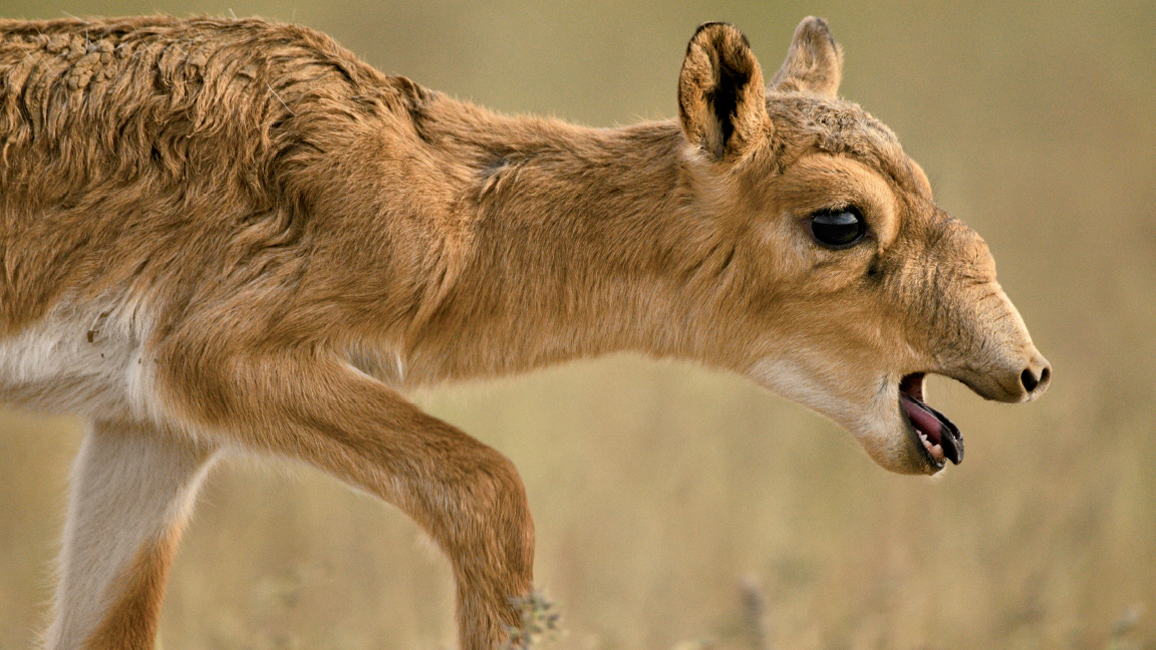
In “Steppe” with Saigas
By Hannah Schardt; photos by Klaus Nigge
This newborn saiga (SYE- guh) antelope is calling for its mother. Mom is grazing nearby, but without her, the little calf is helpless and hungry in a big, scary world. Even when it grows up, this saiga’s life won’t be easy. Saigas live in a harsh, wind-swept place in Eurasia called the steppe (see map below). Most animals wouldn’t be able to live there. But the saiga is built for steppe survival.
ON THE MOVE
A saiga herd can travel 72 miles in a single day. That’s farther than two and a half marathons!
Where saigas live
- Russia
- Kazakhstan
- Mongolia
- Uzbekistan
On the Steppe
The steppe (STEP) can be a bleak-looking place: miles and miles of treeless grasslands. In winter, the temperature may dip as low as 40 degrees below zero. And strong, biting winds blow across the empty landscape. Brrr!
When spring arrives, warm rains turn the steppe lush and grassy—paradise for a grazer such as the saiga! But in summer, hot winds often dry out the grasslands, creating a dusty plain.
Nose for Survival
From the neck down, a saiga looks a lot like its cousins, sheep and goats. It has long, skinny legs and a sturdy body. But a saiga’s face is clearly one of a kind. A long, bulbous nose droops down over the antelope’s mouth. That showy schnoz isn’t just for looks. In winter, heat from the nose warms the air before the saiga breathes it into its lungs. And in summer, a saiga can use its nose to filter dust out of the hot, dry air. During mating season, male saigas inflate their droopy noses to show off for females.
It’s a Herd Life
Like all antelopes, saigas hang out in herds. Saiga herds are made up of dozens of animals—for most of the year, at least. During one week in spring, females from many different herds gather together in groups of thousands to have their babies. With so many saigas keeping an eye out for wolves, eagles, and other hungry predators, the super-sized herd can keep most babies safe.
IN THE SNOW
With its shaggy, white winter coat and long, droopy nose, this saiga looks like a Star Wars character.
CHECKING UP ON SAIGAS
Scientists use a special scale to weigh a newborn saiga calf.
Mass Movement
Each spring, tens of thousands of saiga antelopes join up in one enormous group. Together the saigas set out on one of nature’s most amazing migrations, walking and running hundreds of miles to the northern part of the steppe. (The babies are born during this trip north.) There they spend the summer feasting on lush grass. In fall, they turn around and make the long trip back. With winter approaching, the antelopes must avoid the heavy snow and ice that will blanket the ground up north.
Troubled Times
Only 40 years ago, two million saigas roamed the steppes of Europe and Asia. But then, poachers started illegally killing many of the antelopes for their meat and horns. (Some people wrongly believe that the horns can be used for medicine.)
And then, a few years ago, thousands of saigas started getting sick and dying. Sometimes, a whole herd would die at once. Scientists still aren’t sure why.
Today, only around 100,000 saigas remain. But there is good news: All the countries where saigas live have agreed to protect them. The governments of those countries are tracking down poachers, so poachers aren’t killing as many saigas as before. Also, scientists are working hard to figure out what’s making the antelopes sick—and how to fix the problem. So don’t sigh for saigas. After all, these hardy antelopes are built to survive!
“In the ‘Steppe’ with Saigas” originally appeared in the April 2016 issue of Ranger Rick magazine.
(Click on each image above for a closer view of the story.)



















